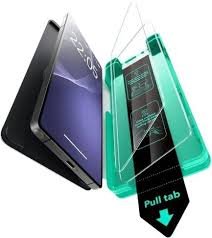Smartphones are no longer just communication devices. They hold our work, photos, bank accounts, and even our identities. Yet, despite all the technology packed into them, their most fragile part is still the screen. One careless drop, and you’re staring at a spiderweb of cracks. That’s where a tempered glass screen protector becomes essential.
Replacing a cracked screen can cost anywhere from $150 to $400, depending on the model. Meanwhile, a tempered glass screen protector usually costs less than a dinner out. It’s a simple upgrade that saves you hundreds in repair bills, keeps your phone looking brand-new, and gives you peace of mind.
This in-depth guide explores everything you need to know about tempered glass protectors their benefits, features, comparisons, myths, installation process, and even the best models available in 2025.
What Is a Tempered
A tempered glass screen protector is a thin, transparent sheet of reinforced glass designed to fit over your phone’s screen. Unlike plastic films that merely guard against light scratches, tempered glass provides real protection against both scratches and drops.
The science behind it is fascinating. Tempered glass is created by heating ordinary glass to over 600°C (1,112°F) and then cooling it rapidly. This process strengthens the glass by creating surface tension, making it four to five times stronger than untreated glass.
Key traits of tempered glass:
- Thickness ranges between 0.2mm and 0.5mm, thin enough to be almost invisible.
- Scratch resistance of 9H on the hardness scale.
- Designed to absorb shock by cracking itself instead of your phone’s screen.
Fun fact: The same process used in tempered glass protectors is also applied to car windows, building facades, and even bullet-resistant glass.
Benefits of Using
Why should you choose tempered glass over cheaper alternatives? Let’s break down the main benefits.
1. Superior Scratch Resistance
Everyday life puts your phone at risk. Keys in your pocket, coins in your bag, or even grit from a table can scratch a screen. With a hardness level of 9H, tempered glass resists scratches from most common objects.
Example: Imagine slipping your phone into your jeans pocket with a set of keys. Without protection, you’ll likely see faint scratches. With tempered glass, the protector absorbs the abuse, leaving your actual screen flawless.
2. Impact and Drop Protection
Tempered glass doesn’t just resist scratches it also absorbs impact. When you drop your phone, the protector takes the hit and often cracks itself, sacrificing for the main display. Replacing the protector costs $10–$20 compared to hundreds for a new screen.
3. Preserves Clarity and Sensitivity
Worried about dullness? High-quality tempered glass is virtually invisible. It retains the phone’s HD resolution, vivid colors, and smooth responsiveness. In fact, many protectors include advanced coatings that reduce glare and resist fingerprints.
4. Easy Installation and Maintenance
Older protectors were notorious for bubbles and dust. Today, most brands use bubble free adhesives and even include installation kits with alignment frames. Maintenance is simple wipe with a microfiber cloth and you’re good to go.
Tempered Glass vs. Other Types of Screen Protectors
With several types of screen protectors on the market, how does tempered glass compare?
| Feature | Tempered Glass | Plastic Film | Hydrogel Protector |
| Scratch Resistance | Excellent (9H) | Low | Medium |
| Drop Protection | High | Very low | Medium |
| Clarity & Touch Sensitivity | Excellent | Moderate | Excellent |
| Thickness | 0.2mm–0.5mm | Ultra-thin | Thin & flexible |
| Installation | Easy, bubble-free | Tricky, prone to bubbles | Easy, self-healing edges |
| Replacement Frequency | 6–12 months | 2–3 months | 4–6 months |
Verdict: Plastic films are outdated and offer minimal protection. Hydrogel protectors are flexible and great for curved screens but don’t last as long. Tempered glass strikes the best balance of durability, clarity, and ease of use.
Key Features to Look
Not all tempered glass protectors are equal. Here’s what you should look for before buying:
- Thickness: Standard protectors are 0.3mm thick. Thinner ones (0.2mm) feel sleeker but may break more easily.
- Oleophobic Coating: Repels oils and reduces fingerprints. Essential for a clean look.
- Shatterproof Design: Quality protectors crack safely without splintering into sharp pieces.
- Case Friendly Fit: Protectors cut slightly smaller to fit inside phone cases without lifting.
- Edge to Edge Coverage: Some models cover curved screens fully.
- Blue Light Filtering: Filters harmful blue light, reducing eye strain during long usage.
Pro tip: Always check compatibility with your phone model. A misfit protector can cause touch issues or peel at the edges.
How to Install a Tempered Glass Screen Protector Correctly
Even the best protector won’t help if installed poorly. Here’s the foolproof method:
Step-by-Step Guide
- Wash your hands to avoid oils and dust.
- Clean the screen with the included alcohol wipe.
- Use a dust sticker or tape to remove tiny particles.
- Align the protector carefully using the guide frame (if included).
- Place it gently and press from the center outward.
- Smooth with a microfiber cloth to remove air bubbles.
Common Mistakes to Avoid
- Installing in a dusty room: Even one speck of dust causes bubbles.
- Rushing alignment: Take your time; misaligned protectors are frustrating.
- Reusing old protectors: Adhesive weakens once removed.
Case Study: A phone repair shop in New York reported that nearly 60% of cracked screens they fix had either no protector or a misaligned one, showing how crucial proper installation is.
How to Maintain
Maintenance is simple, but a few habits extend the protector’s lifespan.
- Clean regularly with a microfiber cloth. Avoid paper towels or tissues that can scratch.
- Avoid harsh cleaners like ammonia-based sprays. Use mild, alcohol-free solutions.
- Check for cracks after drops. Even a hairline fracture weakens protection.
- Replace as needed. Most last 6–12 months, but frequent drops may shorten this.
Common Myths
Several misconceptions discourage people from using them. Let’s clear them up.
- Myth: They reduce touch sensitivity.
Truth: Quality protectors are ultra-thin and maintain full sensitivity. Many support fingerprint unlock as well. - Myth: They make screens look dull.
Truth: Cheap ones might, but premium tempered glass keeps your screen bright and vibrant. - Myth: All protectors are the same.
Truth: Materials, adhesive quality, and coatings vary widely. Investing in a reputable brand makes a big difference.
Best Tempered Glass Screen Protectors in 2025
With so many brands, it’s hard to know what’s worth your money. Here are some top picks:
| Brand / Model | Key Features | Price Range | Best For |
| Spigen Glas.tR EZ Fit | Easy installation kit, case-friendly design | $12–$15 | Everyday durability |
| amFilm OneTouch | Ultra-clear, bubble-free adhesive | $10–$12 | Budget-friendly quality |
| ZAGG InvisibleShield | Blue light filter, shatter protection | $25–$30 | Premium protection |
| Whitestone Dome Glass | Full adhesive, great for curved screens | $35–$45 | High-end phones with edges |
Recommendation: If you own a phone with curved edges (like Samsung Galaxy models), Whitestone Dome Glass offers the best fit. For iPhone users, Spigen Glas.tR provides a hassle-free install and reliable durability.
Real Life Case Studies
- The Commuter Drop
A daily train commuter dropped his iPhone on concrete. The tempered glass protector shattered instantly, but the phone’s screen was flawless. Replacement cost: $15 instead of $300. - The Toddler Test
Parents with young kids know the chaos. One mother reported her toddler tossing her phone across the room. The tempered glass cracked in three places, but her screen remained perfect. - The Worksite Survivor
A construction worker used his phone daily around tools and gravel. His tempered glass protector had deep scratches after three months, but his actual screen remained untouched.
Final Thoughts
A tempered glass screen protector is more than just an accessory it’s essential insurance for your smartphone. It prevents scratches, absorbs shock, and saves you from costly repairs. Compared to plastic films and hydrogel protectors, tempered glass delivers the best balance of strength, clarity, and ease of use.
If you’re shopping in 2025, prioritize features like thickness, oleophobic coating, and case compatibility. Choose trusted brands like Spigen, ZAGG, or Whitestone for peace of mind.
In the end, the choice is simple: spend a few dollars now on protection, or risk spending hundreds later on repairs. A tempered glass protector is a small investment with a huge payoff.



